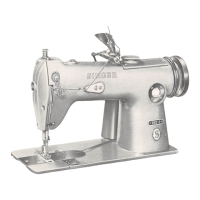LIFTING
SCREW
LIFTING
BRACKET
Fig.
23« Setting
the
Feed
Roll
•••.
•
CEtfTERED
IN.-.r"
/®
NEEDLE
HOLE
0"""
®
4 -
I.//
/V
CENTERED IN
if
NEEDLE
HOLE
^
Fig.
24.
Centralizing
the
Needles
SETTING
THE
FEED
ROLL
AT
CORRECT
HEIGt
;|IACHINE
262.20
AND
262-32^^^ggg^^^||
When
presser foot
rests
firmly on throat plate, feed
roll should cleor throat plate by approximotely .010
to
.016
inch.
There
should
be
a
1/16
Inch
clearance
between
feed roll lifting bracket and feed roll guide.
To adjust, loosen feed lifting screw and guide
screw shown In Fig. 23.
Set feed roller approximately .010 to .016 inch above
throat plate and position feed roll guide on bushing,
as shown in Fig. 23. Tighten guide screw.
Raise
or lower feed lifting bracket so
that
there is
a slight clearonce between bracket and feed lifting
guide,
as
shown in
Fig.
23. Then
tighten
feed lifting
NOTE: it may be necessary to vary height of feed rol
when changing from one material to
another.
ADJUSTING
THE
SEWING
MECHANISM
NOTE: The adjustments detailed on the following pages
ore based upon the location of the left or front looper
in relation to the
setting
of the left or front
needle.
Instructions covering left looper or needle
also
apply
to
single
looper and
single
needle machines.
CAUTION: Before making any adjustments, make certain
that needle bar is correctly turned as Instructed below
and
that
ioopers
are
parallel in looper carrier.
CENTRALIZING
THE
NEEDLES
IN
NEEDLE
HOLEI
OF
THROAT
PLATE
AND
PRESSER
FOOT
When
needles pass through needle holes in throat
plate and
presser
foot,
each
needle should be
centered
in the needle hole as shown in Fig. 24.
To
adjust,
remove
presser
foot and loosen
needle
bar clamping
screw.
Turn needle bar
as
required to
center
needles
in
holes.
Tighten needle bar clamping screw and replace
presser
foot.

